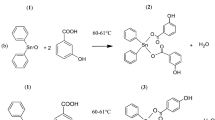Abstract
The opening of epoxy rings from (2′Z)-N-1-(oxiran-2-ylmethyl)indirubin (2) and (2′Z-3′E)-indirubin-3ʹ-[O-oxiran-2-ylmethyl)oxime] (6) with thiols gave 17 new derivatives of indirubin in good yields. Their structures were elucidated by 1D-, 2D-NMR and HRMS spectra. Screening for anticancer activity was performed with four human cancer cell lines: SW480, LU-1, HepG2 and HL-60 in comparison with indirubin, indirubin-3′-oxime and 6-mercaptopurine. The results showed that cytotoxic and anti-proliferative activities of five derivatives were found in the range of 1.35–19.24 µM. Among synthesized derivatives, 4f showed the strongest activity against all four tested cancer cell lines with IC50 values of 1.65, 2.21, 1.90 and 1.35 µM, respectively.


Similar content being viewed by others
References
Bektas I, Karaman S, Diraz E, Celik M (2016) The role of natural indigo dye in alleviation of genotoxicity of sodium dithionite as reducing agent. Cytotechnology 63:2245–2255. https://doi.org/10.1007/s10616-016-0018-7
Choi OM, Cho YH, Choi S, Lee SH, Seo SH, Kim HY, Han G, Min DS, Park T, Choi KY (2014) The small molecule indirubin-3′-oxime activates Wnt/b-catenin signaling and inhibits adipocyte differentiation and obesity. Int J Obes 38:1044–1052. https://doi.org/10.1038/ijo.2013.209
Cuong NM, Thuy DTT, Ha NV, Tai BH (2007) Isolation of indirubin from the leaves of Strobilanthes cusia. J Sci Technol 45(3A):195–199
Cuong NM, Tai BH, Hoan DH, Long PQ, Choi EM, Kim YH (2010a) Synthesis and anti-osteoporosis potential of two new indirubin-3-oxime derivatives. J Korean Soc Appl Biol Chem 53:22–26. https://doi.org/10.3839/jksabc.2010.004
Cuong NM, Tai BH, Hoan DH, Huong TT, Kim YH, Hyun JH, Kang HK (2010b) Inhibitory effects of indirubin derivatives on the growth of HL-60 leukemia cell. Nat Prod Commun 5:103–106
Cuong NM, Tai BH, Hoan DH (2010c) Studies on acetylation and NMR reassignment of indirubin derivatives. Nat Prod Res 24:99–105. https://doi.org/10.1080/14786410802300469
Gilani SJ, Khan SA, Alam O, Siddiqui N (2011) Synthesis and in vitro antimicrobial evaluation of condensed heterocyclic 6-substituted 1,2,4-triazolo-[3.4-b]-1,3,4-thiadiazole and 1,3,4-oxadiazole derivatives of isoniazid. Acta Pol Pharm 68:205–211
Girard SK, Mialou V, Chebel A, Chien WW, Tigaud I, Mokdad F, Badiou C, Ffrench M (2007) Inhibition of normal lymphocyte proliferation by Indirubin-30-monoxime: a multifactorial process. Leukemia & Lymphoma 48:605–615. https://doi.org/10.1080/10428190601059696
Hoessel R, Leclerc S, Endicott JA, Nobel ME, Lawrie A, Tunnah P, Leost M, Damiens E, Marie D, Marko D, Niederberger E, Tang W, Eisenbrand G, Meijer L (1999) Indirubin, the active constituent of a Chinese antileukaemia medicine, inhibits cyclin-dependent kinases. Nat Cell Biol 1:60–67. https://doi.org/10.1038/9035
Ichimaru Y, Saito H, Uchiyama T, Metori K, Tabata K, Suzuki T, Miyairi S (2015) Indirubin 3´-(O-oxiran-2-ylmethyl)oxime: a novel anticancer agent. Bioorg Med Chem Lett 25:1403–1406. https://doi.org/10.1016/j.bmcl.2015.02.053
Jung ME, Byun BJ, Kim HM, Lee JY, Park JH, Lee N, Son YH, Choi SU, Yang KM, Kim SJ, Lee KH, Kim YC, Choi G (2016) Discovery of indirubin derivatives as new class of DRAK2 inhibitors from high throughput screening. Bioorganic Med Chem Lett 26:2719–2723. https://doi.org/10.1016/j.bmcl.2016.03.111
Karapetyan G, Chakrabarty K, Hein M, Langer P (2011) Synthesis and Bioactivity of carbohydrate derivatives of indigo, its isomers and heteroanalogues. Med Chem Med 6:25–37. https://doi.org/10.1002/cmdc.201000374
Lectere S, Garnier M, Hoessel R, Marko D, Bibb JA, Snyder GL, Greengard P, Biernard J, Wu YZ, Mandelkow EM, Eisenbrand G, Meijer L (2001) Indirubins inhibit glycogen synthase kinase-3β and CDK5/P25, two protein kinases involved abnormal tau phosphorylation in alzheimer’s disease. J Biol Chem 276:251–260. https://doi.org/10.1074/jbc.M002466200
Liao XM, Leung KN (2013) Indirubin-3-oxime induces mytochondrial dysfunction and triggers growth inhibition in cell cycle arrest in human neuroblastoma cells. Oncol Rep 29:371–379. https://doi.org/10.3892/or.2012.2094
Lo WY, Chang NW (2013) An indirubin derivative, indirubin-3′-monoxime suppresses oral cancer tumorigenesis through the down regulation of survivin. PLoS ONE. https://doi.org/10.1371/journal.pone.0070198
Meijer L, Skaltsounis AL, Magiatis P, Polychronopoulos P, Leost M, Ryan XP, Vonica CA, Brivanlou A, Dajani R, Crovace C, Tarricone C, Musacchio A, Roe SM, Pearl L, Greengard P (2003) GSK-3-Selective inhibitors derived from tyrian purple indirubins. Chem Biol 10:1255–1266. https://doi.org/10.1016/j.chembiol.2003.11.010
Monks A, Scudiero D, Skehan P, Shoemaker R, Paull K, Vistica D, Hose C, Langley J, Cronise P, Vaigro-Wolff A, Gray-Goodrich M (1991) Feasibility of a high-flux anticancer drug screen using a diverse panel of cultured human tumor cell lines. J Natl Cancer Inst 83:757–766. https://doi.org/10.1093/jnci/83.11.757
Nam SK, Buettner R, Turkson J, Kim DH, Cheng JQ, Muehlbeyer S, Hippe F, Vatter S, Merz KH, Eisenbrand G, Jove R (2005) Indirubin derivatives inhibit stat3 signaling and induce apoptosis in human cancer cells. PNAS 102:5998–6003. https://doi.org/10.1073/pnas.0409467102
Perrin DD, Armarego WLF (1988) Purification of Laboratory Chemical, 3rd edn. Pergamon Press, Oxford
Raju GN, Prathyusha TG, Sowmya PL, Mounika SJ, Nadendla RR (2015) Synthesis, characterization and biological activity of some 1,3,4-oxadiazole derivatives with benzothiazole moiety. Der Pharmacia Sinica 6:1–8
Riepl HM, Urmann C (2012) Improved synthesis of indirubin derivatives by sequential Buid-up of indoxyl unit: first preparation of fluorescent indirubins. Helv Chim Acta 95:1461–1477. https://doi.org/10.1002/hlca.201200042
Sano M, Ichimaru Y, Kurita M, Hayashi E, Homma T, Saito H, Masuda S, Nemoto N, Hemmi A, Suzuki T, Miyairi S, Hao H (2017) Induction of cell death in pancreatic ductal adenocarcinoma by indirubin 3′-oxime and 5-methoxyindirubin 3′-oxime in vitro and in vivo. Can Lett 397:72–82. https://doi.org/10.1016/j.canlet.2017.03.031
Stasiak N, Koch WK, Glowniak K (2014) Modern industrial and pharmacological applications of indigo dye and its derivatives—a review. Acta Poloniae Pharmaceutica Drug Research 71:215–221
Vaughan JR (1957) Heterocyclic sulphonamides. US patent 2783240
Xiao Hao Y, Liu B, Qian L (2002) Indirubin and Mesoindigo in the Treatment of Chronic Myelogenous Leukemia in China. Leukemia and lymphoma 43:1763–1768
Acknowledgements
The authors gratefully acknowledge Vietnam-Russia Tropical Center and Vietnam Academy of Science and Technology (VAST) for financial support via project VAST.HTQT.BELARUS.04/15-16.
Author information
Authors and Affiliations
Corresponding authors
Ethics declarations
Conflict of interest
The authors declare no conflicts of interest.
Rights and permissions
About this article
Cite this article
Nguyen, D.T., Truong, G.N., Van Vuong, T. et al. Synthesis of new indirubin derivatives and their in vitro anticancer activity. Chem. Pap. 73, 1083–1092 (2019). https://doi.org/10.1007/s11696-018-0659-4
Received:
Accepted:
Published:
Issue Date:
DOI: https://doi.org/10.1007/s11696-018-0659-4




